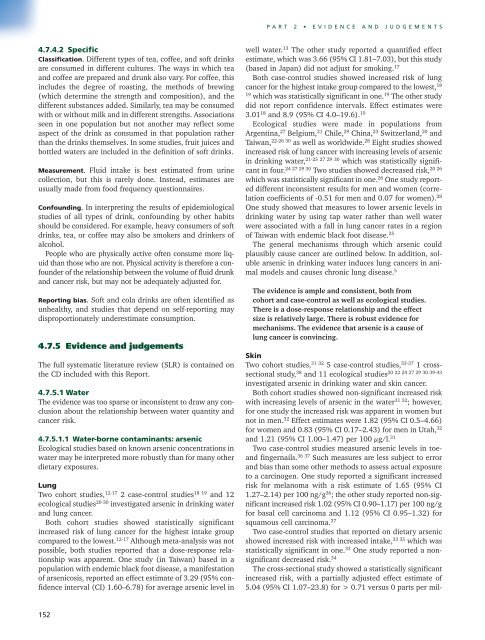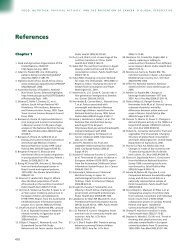Full Report - Food, Nutrition, and the Prevention of Cancer
Full Report - Food, Nutrition, and the Prevention of Cancer
Full Report - Food, Nutrition, and the Prevention of Cancer
Create successful ePaper yourself
Turn your PDF publications into a flip-book with our unique Google optimized e-Paper software.
4.7.4.2 Specific<br />
Classification. Different types <strong>of</strong> tea, c<strong>of</strong>fee, <strong>and</strong> s<strong>of</strong>t drinks<br />
are consumed in different cultures. The ways in which tea<br />
<strong>and</strong> c<strong>of</strong>fee are prepared <strong>and</strong> drunk also vary. For c<strong>of</strong>fee, this<br />
includes <strong>the</strong> degree <strong>of</strong> roasting, <strong>the</strong> methods <strong>of</strong> brewing<br />
(which determine <strong>the</strong> strength <strong>and</strong> composition), <strong>and</strong> <strong>the</strong><br />
different substances added. Similarly, tea may be consumed<br />
with or without milk <strong>and</strong> in different strengths. Associations<br />
seen in one population but not ano<strong>the</strong>r may reflect some<br />
aspect <strong>of</strong> <strong>the</strong> drink as consumed in that population ra<strong>the</strong>r<br />
than <strong>the</strong> drinks <strong>the</strong>mselves. In some studies, fruit juices <strong>and</strong><br />
bottled waters are included in <strong>the</strong> definition <strong>of</strong> s<strong>of</strong>t drinks.<br />
Measurement. Fluid intake is best estimated from urine<br />
collection, but this is rarely done. Instead, estimates are<br />
usually made from food frequency questionnaires.<br />
Confounding. In interpreting <strong>the</strong> results <strong>of</strong> epidemiological<br />
studies <strong>of</strong> all types <strong>of</strong> drink, confounding by o<strong>the</strong>r habits<br />
should be considered. For example, heavy consumers <strong>of</strong> s<strong>of</strong>t<br />
drinks, tea, or c<strong>of</strong>fee may also be smokers <strong>and</strong> drinkers <strong>of</strong><br />
alcohol.<br />
People who are physically active <strong>of</strong>ten consume more liquid<br />
than those who are not. Physical activity is <strong>the</strong>refore a confounder<br />
<strong>of</strong> <strong>the</strong> relationship between <strong>the</strong> volume <strong>of</strong> fluid drunk<br />
<strong>and</strong> cancer risk, but may not be adequately adjusted for.<br />
<strong>Report</strong>ing bias. S<strong>of</strong>t <strong>and</strong> cola drinks are <strong>of</strong>ten identified as<br />
unhealthy, <strong>and</strong> studies that depend on self-reporting may<br />
disproportionately underestimate consumption.<br />
4.7.5 Evidence <strong>and</strong> judgements<br />
The full systematic literature review (SLR) is contained on<br />
<strong>the</strong> CD included with this <strong>Report</strong>.<br />
4.7.5.1 Water<br />
The evidence was too sparse or inconsistent to draw any conclusion<br />
about <strong>the</strong> relationship between water quantity <strong>and</strong><br />
cancer risk.<br />
4.7.5.1.1 Water-borne contaminants: arsenic<br />
Ecological studies based on known arsenic concentrations in<br />
water may be interpreted more robustly than for many o<strong>the</strong>r<br />
dietary exposures.<br />
Lung<br />
Two cohort studies, 12-17 2 case-control studies 18 19 <strong>and</strong> 12<br />
ecological studies 20-30 investigated arsenic in drinking water<br />
<strong>and</strong> lung cancer.<br />
Both cohort studies showed statistically significant<br />
increased risk <strong>of</strong> lung cancer for <strong>the</strong> highest intake group<br />
compared to <strong>the</strong> lowest. 12-17 Although meta-analysis was not<br />
possible, both studies reported that a dose-response relationship<br />
was apparent. One study (in Taiwan) based in a<br />
population with endemic black foot disease, a manifestation<br />
<strong>of</strong> arsenicosis, reported an effect estimate <strong>of</strong> 3.29 (95% confidence<br />
interval (CI) 1.60–6.78) for average arsenic level in<br />
152<br />
P ART 2 • EVIDENCE AND JUDGEMENTS<br />
well water. 13 The o<strong>the</strong>r study reported a quantified effect<br />
estimate, which was 3.66 (95% CI 1.81–7.03), but this study<br />
(based in Japan) did not adjust for smoking. 17<br />
Both case-control studies showed increased risk <strong>of</strong> lung<br />
cancer for <strong>the</strong> highest intake group compared to <strong>the</strong> lowest, 18<br />
19 19 which was statistically significant in one. The o<strong>the</strong>r study<br />
did not report confidence intervals. Effect estimates were<br />
3.0118 <strong>and</strong> 8.9 (95% CI 4.0–19.6). 19<br />
Ecological studies were made in populations from<br />
Argentina, 27 Belgium, 21 Chile, 29 China, 23 Switzerl<strong>and</strong>, 20 <strong>and</strong><br />
Taiwan, 22-26 30 as well as worldwide. 28 Eight studies showed<br />
increased risk <strong>of</strong> lung cancer with increasing levels <strong>of</strong> arsenic<br />
in drinking water, 21-25 27 29 30 which was statistically signifi-<br />
cant in four. 24 27 29 30 Two studies showed decreased risk,<br />
20 26<br />
which was statistically significant in one. 26 One study reported<br />
different inconsistent results for men <strong>and</strong> women (correlation<br />
coefficients <strong>of</strong> -0.51 for men <strong>and</strong> 0.07 for women). 28<br />
One study showed that measures to lower arsenic levels in<br />
drinking water by using tap water ra<strong>the</strong>r than well water<br />
were associated with a fall in lung cancer rates in a region<br />
<strong>of</strong> Taiwan with endemic black foot disease. 25<br />
The general mechanisms through which arsenic could<br />
plausibly cause cancer are outlined below. In addition, soluble<br />
arsenic in drinking water induces lung cancers in animal<br />
models <strong>and</strong> causes chronic lung disease. 5<br />
The evidence is ample <strong>and</strong> consistent, both from<br />
cohort <strong>and</strong> case-control as well as ecological studies.<br />
There is a dose-response relationship <strong>and</strong> <strong>the</strong> effect<br />
size is relatively large. There is robust evidence for<br />
mechanisms. The evidence that arsenic is a cause <strong>of</strong><br />
lung cancer is convincing.<br />
Skin<br />
Two cohort studies, 31 32 5 case-control studies, 33-37 1 crosssectional<br />
study, 38 20 22 24 27 29 30 39-43<br />
<strong>and</strong> 11 ecological studies<br />
investigated arsenic in drinking water <strong>and</strong> skin cancer.<br />
Both cohort studies showed non-significant increased risk<br />
with increasing levels <strong>of</strong> arsenic in <strong>the</strong> water31 32 ; however,<br />
for one study <strong>the</strong> increased risk was apparent in women but<br />
not in men. 32 Effect estimates were 1.82 (95% CI 0.5–4.66)<br />
for women <strong>and</strong> 0.83 (95% CI 0.17–2.43) for men in Utah, 32<br />
<strong>and</strong> 1.21 (95% CI 1.00–1.47) per 100 µg/l. 31<br />
Two case-control studies measured arsenic levels in toe<strong>and</strong><br />
fingernails. 36 37 Such measures are less subject to error<br />
<strong>and</strong> bias than some o<strong>the</strong>r methods to assess actual exposure<br />
to a carcinogen. One study reported a significant increased<br />
risk for melanoma with a risk estimate <strong>of</strong> 1.65 (95% CI<br />
1.27–2.14) per 100 ng/g36 ; <strong>the</strong> o<strong>the</strong>r study reported non-significant<br />
increased risk 1.02 (95% CI 0.90–1.17) per 100 ng/g<br />
for basal cell carcinoma <strong>and</strong> 1.12 (95% CI 0.95–1.32) for<br />
squamous cell carcinoma. 37<br />
Two case-control studies that reported on dietary arsenic<br />
showed increased risk with increased intake, 33 35 which was<br />
statistically significant in one. 33 One study reported a nonsignificant<br />
decreased risk. 34<br />
The cross-sectional study showed a statistically significant<br />
increased risk, with a partially adjusted effect estimate <strong>of</strong><br />
5.04 (95% CI 1.07–23.8) for > 0.71 versus 0 parts per mil-



